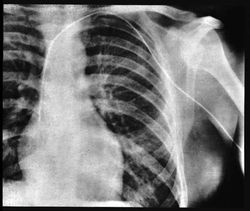Development of heart catheterization
 Generally thought to be impossible without causing severe damage to and threading it through until it reaches the heart. This would allow clinicians to measure the pressure in the heart and determine if a defect needs to be operated on. Inspired by researchers who had achieved this in a horse in 1861, Forssmann saw the potential this technique could have.
Generally thought to be impossible without causing severe damage to and threading it through until it reaches the heart. This would allow clinicians to measure the pressure in the heart and determine if a defect needs to be operated on. Inspired by researchers who had achieved this in a horse in 1861, Forssmann saw the potential this technique could have.
Refused permission to experiment on patients, Forssmann set out to test the technique on himself. First he had to convince the operating room nurse to give him access to surgical instruments. She relented on the condition that Forssmann would place the catheter in her instead, which he accepted. However, once he had strapped the nurse down onto the operating table, Forssmann quickly anaesthetised his own arm, made an incision and inserted the catheter 30 cm along his veins. He then walked up two flights of stairs to the x-ray room before extending the catheter the full 60 cm to enter his heart and taking the picture shown.
Forssmann’s reckless bravery generated much annoyance and excitement. The annoyance eventually won out and Forssmann was forced to withdraw from his residency. Although he moved out of research, Forssmann’s paper on his work was read many years later by André Frédéric Cournand and Dickinson W. Richards who built on the technique and shared the Nobel Prize with him. On hearing news of the Prize, Forssmann said, ‘I feel like a village parson who has just learned that he has been made bishop.’
Last edited: 27 August 2014 05:57
